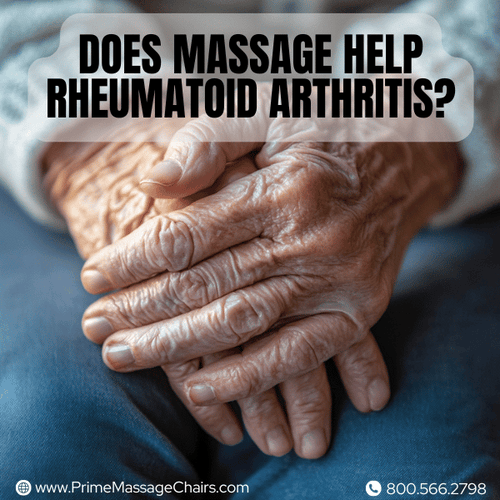
Does Massage Help Rheumatoid Arthritis? Find Out Now!
For anyone wondering, "Does massage help rheumatoid arthritis?" the answer may depend on individual symptoms and treatment goals.
Our article guides you on how massages could ease your pain and improve mobility.
Keep reading to learn more.
How Massage Helps with Rheumatoid Arthritis
Massage may help people with rheumatoid arthritis by reducing pain and stiffness. It could also enhance joint mobility and decrease swelling.
However, massage therapy should not replace medical treatments or advice from a healthcare provider.
Reducing Pain and Stiffness
Massage therapy may provide benefits for people with rheumatoid arthritis.
This kind of treatment could improve hand and joint mobility. Imagine how much easier it might be to open a jar or write without significant pain.
Regular massage may decrease pain and increase activity levels. This approach could boost blood flow, which might help reduce inflammation.

Less inflammation often means less pain and more freedom to move. Massages could improve the day-to-day life of someone dealing with rheumatoid arthritis.
It's all about possibly relieving those sore joints so you can continue doing what you love.
Improving Joint Mobility and Flexibility
Keeping joints flexible may help people with arthritis perform daily tasks more easily. Massage therapy could support this by improving joint movement and flexibility.
This means you might be able to open jars, walk, or get up from a chair with greater ease.
Studies suggest that people who receive massages experience improved mobility compared to those who don’t.
They may also have a stronger hand grip. Regular Swedish massages could reduce pain and may lessen the need for pain medication.
Next, we'll look at the best types of massage for rheumatoid arthritis.
Enhancing Blood Flow and Reducing Inflammation
Improved joint movement is crucial, and enhancing blood circulation plays a vital role. Simple massage techniques, such as effleurage and Swedish massage, could be excellent for this.
These methodologies may improve circulation and help combat inflammation. This is significant, particularly for individuals suffering from rheumatoid arthritis.
Consistent massages might not only ease movement but also reduce discomfort. Studies suggest that Swedish massage alleviates physical discomfort and mitigates stiffness.
By receiving regular massages, individuals may report reduced pain levels and improved ability to perform daily tasks.
Moderate-pressure massages could be ideal for reducing inflammation and promoting health among those managing this challenging condition.
Best Types of Massage for Rheumatoid Arthritis
For those with rheumatoid arthritis, finding the right kind of massage could make a world of difference.
Swedish massage, deep tissue massage, reflexology, and aromatherapy massage stand out as some of the best options to ease your symptoms.
Swedish Massage
This massage is a therapeutic option for people with rheumatoid arthritis.
Research published by the National Center for Complementary and Integrative Health suggests that Swedish massage may reduce inflammation and improve mobility for individuals with rheumatoid arthritis.

This research indicated that Swedish massages could reduce pain levels and lessen the need for painkillers among patients undergoing regular treatments over a two-month period.
Swedish massage works by improving blood flow, easing muscle tension, and enhancing joint flexibility.
It’s not just about relaxation; it’s about possibly helping your body function better.
Now, let’s explore deep tissue massage as another option for managing rheumatoid arthritis symptoms.
Deep Tissue Massage
Deep tissue massage may provide a different approach for those with rheumatoid arthritis.
It uses firm pressure to reach deeper muscles, focusing on areas of stiffness and soreness.
However, individuals should avoid this technique if it causes pain.
Deep tissue massage targets deeper muscle layers and may help relieve tight muscles often associated with arthritis.
Patients must communicate with their therapist about discomfort to ensure the treatment is beneficial.
It is important to consult with a healthcare provider before trying deep tissue massage, as it may not be suitable for everyone with RA.
Reflexology
Reflexology focuses on pressing specific points on the feet. People with rheumatoid arthritis also report better sleep and reduced anxiety after reflexology.
While more research is needed to explore the long-term effects and mechanisms, current findings suggest that massage therapy could reduce pain and fatigue associated with rheumatoid arthritis.
Aromatherapy Massage
Aromatherapy massage combines essential oils with therapeutic touch to provide relief.

This method combines precise strokes with the therapeutic effects of natural oils.
It’s an excellent option for possibly improving pain management and quality of life for those with rheumatoid arthritis.
Self-Massage Techniques for Managing RA
Managing RA pain might get easier with self-massage.
Techniques like gentle rubbing or kneading may help improve joint flexibility and reduce stiffness. Self-massage could also boost blood flow, reducing swelling.
Stroking
Stroking involves sliding your hand from wrist to shoulder, applying moderate pressure.
This technique may help ease pain and stiffness, especially in the morning or before bedtime.
For additional relief, use a handheld massager. Stroking targets sore spots directly, possibly providing significant pain relief.
Skin Rolling
Skin rolling involves gently pinching and rolling the skin. This light-pressure technique may relax the top layers of soft tissue and reduce discomfort.
Using this method daily could complement professional treatments.
Friction Techniques
Friction techniques involve circular finger movements on the arm, shoulder, and hand. These techniques may alleviate symptoms when practiced with moderate pressure.
Friction techniques might enhance mobility and reduce pain, improving overall quality of life for individuals with rheumatoid arthritis.
Tips for Choosing a Massage Therapist
Finding the right massage therapist is essential for those with rheumatoid arthritis.
Look for someone experienced with RA patients and ensure they have proper licensing and certification.
Look for Experience with Rheumatoid Arthritis Patients
- An experienced therapist understands how RA affects the body. They tailor their approach to possibly reduce joint pain and inflammation effectively.
- Ask about their experience and certifications from reputable organizations like the American Massage Therapy Association.
Ensure Proper Licensing and Certification
Licensed therapists undergo rigorous training to provide safe and effective care.
Always verify their certification and choose someone qualified to handle your specific needs.
Discuss Your Specific Needs and Limitations
Communicate your medical history, pain points, and treatment goals with your therapist.
Open communication ensures the therapy focuses on possibly providing relief where it’s most needed.
When to Avoid Massage Therapy
If your joints are very swollen or if you have open sores, avoid massage therapy. Consult a doctor if you’re unsure.
Severe Inflammation or Swelling
Avoid massaging swollen joints during flare-ups, as it could worsen symptoms.

Light touches may be safer and more effective during these times. Individuals should consult their doctor to determine whether massage is safe during flare-ups.
Open Wounds or Skin Conditions
Massaging over cuts or skin issues can exacerbate problems. A skilled therapist will know how to avoid these areas while still possibly providing relief.
Additional Benefits of Massage Therapy for RA
Massage therapy does more than ease joint pain. It may also help lower stress and improve sleep quality, making daily life more manageable.
Stress and Anxiety Reduction
Massage therapy may reduce stress hormones like cortisol and increase serotonin levels, promoting relaxation and better mood.
This could lead to fewer pain signals and greater comfort. However, it is not a substitute for prescribed medical interventions for stress or RA-related pain.
Improved Sleep Quality
Massage therapy might help individuals with RA sleep deeper and better by reducing cortisol and increasing serotonin levels.
Better sleep aids recovery and improves overall well-being.
FAQs
Can Swedish Massage Help in Treating Rheumatoid Arthritis?
Swedish massage may provide pain relief and reduce inflammation for people with rheumatoid arthritis. It also improves muscle tone and joint mobility.
How Does a Swedish Massage Work on Patients with Arthritis?
Swedish massage enhances circulation and eases muscle tension, which may help relieve pain and decrease inflammation associated with arthritis.
Are There Controlled Trials Proving Massage’s Effectiveness for RA?
Randomized controlled trials suggest that massage therapy may reduce pain and improve range of motion in patients with rheumatoid arthritis and similar conditions.
What Are the Benefits of Combining Different Types of Massages?
Combining various massage types could ease arthritis symptoms, reduce anxiety, improve flexibility, and decrease reliance on pain medications.
Is It Necessary to See a Licensed Therapist for My First Massage?
Yes, licensed therapists have the training to provide safe and effective treatments for arthritis and related conditions.
Conclusion
Does massage help rheumatoid arthritis, or is it simply a relaxing experience for those living with this chronic condition?
Massage therapy may support managing rheumatoid arthritis.
It could alleviate discomfort, improve joint flexibility, and promote blood circulation. Both Swedish massage and other types may offer relief.
Choosing an expert therapist is crucial, and there are instances to avoid massage, such as during severe flare-ups or with skin conditions.
Beyond pain relief, massage may reduce stress and enhance sleep quality, possibly providing comfort amidst the challenges of living with rheumatoid arthritis.
Disclaimer:
We do not provide medical advice. The content of this article, including text, graphics, and other material, is for informational purposes only. It is not intended to be a substitute for professional medical advice, diagnosis, or treatment. Always seek the advice of your physician or other qualified health provider with any questions you may have regarding a health condition. Never disregard professional medical advice or delay in seeking it because of something you have read in this article or on our website.
